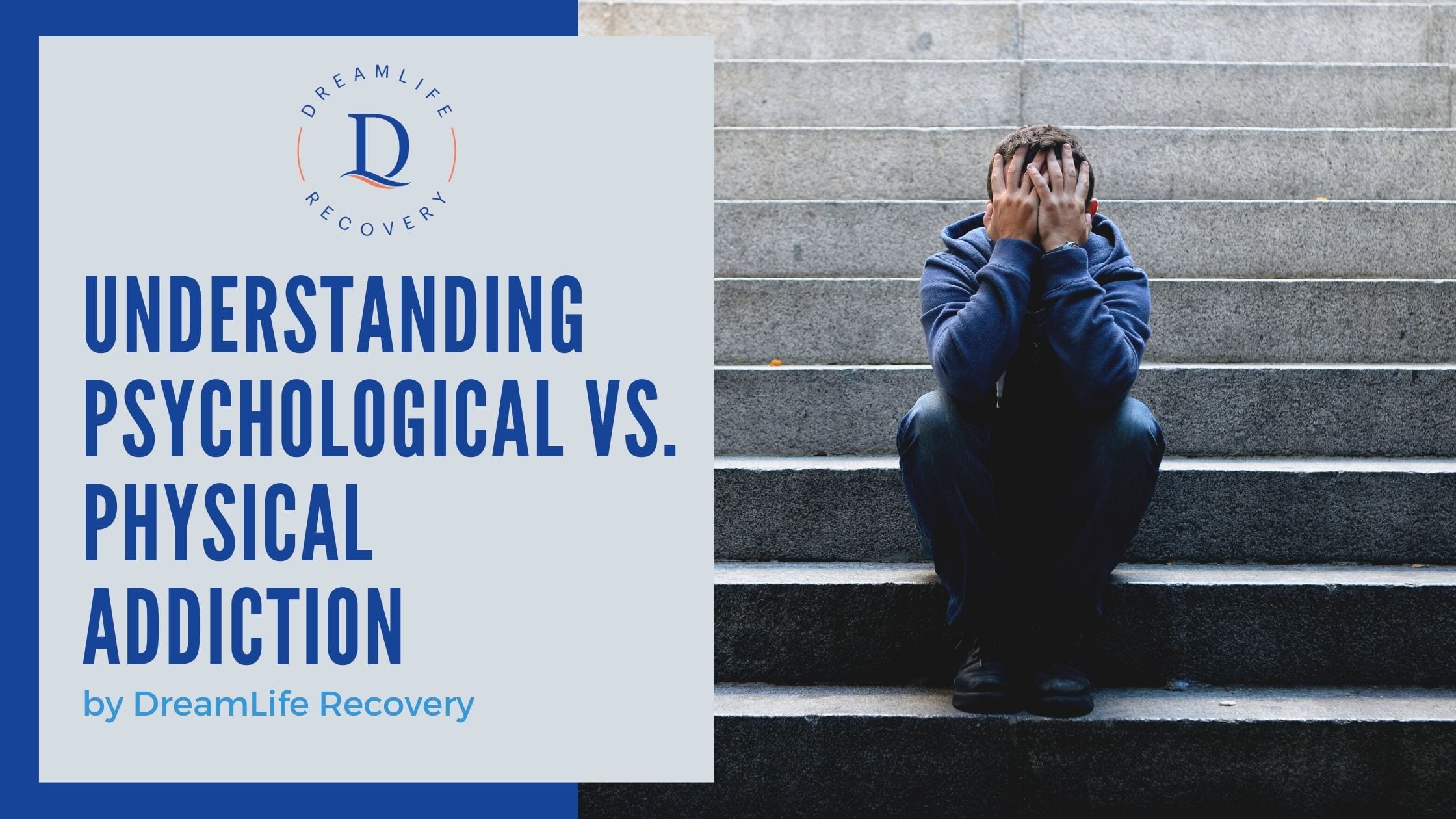Understanding Psychological vs Physical Addiction


Written By
DreamLife RecoveryPeople sometimes consider psychological addiction and physical addiction to a substance to be two separate phenomena. While understandable, this dichotomy is untrue. All addictions have psychological and physical symptoms no matter the substance involved.
What is true is that the psychological and physical elements of the addiction can be unique and have different impacts on the person suffering with the addictive disorder. Typically, when talking about the physical element of addiction, we mean tolerance and dependence on a substance. When talking about the psychological element of addiction, we mean the changes addiction causes in the brain’s reward center and the emotional and mental effects that result from abusing a psychoactive substance like alcohol, opioids, and other drugs.
To understand addiction as a condition that has psychological and physical symptoms, we will look at each of these aspects individually before considering how they interact.
What Does It Mean to Be Physically Addicted?
When we talk about physical effects of addiction, we mean how the body becomes addicted to the substance. Even with prescription medications like antidepressants and painkillers taken as directed, the body develops tolerance and dependence.
Tolerance is when a person requires a higher dosage of the same substance to achieve the same effect. Dependence is when stopping the substance causes withdrawal symptoms that can be both physical and psychological. When a person develops tolerance and dependence on a substance, it means their body chemistry has adjusted and now expects to receive the substance the person has been using. If they stop using the substance, their body, which has become dependent on it to function, registers a deficit and reacts in various ways that can be unpleasant.
You may notice signs of physical dependence if you stop the substance of use and experience symptoms like:
- Nausea/stomach upset
- Headache
- Feeling anxious or irritable
- Shaking hands or body
- Trouble sleeping
What is Psychological Addiction? Physiological Dependence?
While the physical addiction in the form of tolerance and dependence develops, the psychological aspects of addiction are happening simultaneously. The psychological addiction is how the substance of abuse affects a person’s mind and emotions. A person who begins using alcohol to avoid negative feelings becomes dependent on the substance emotionally to cope with difficult times. Psychological dependence begins by training yourself to fix or avoid problems by using or abusing a substance like alcohol that makes you feel better or numb temporarily.
Then there is the physiological element of the addiction, which is how the substance affects brain chemistry and how body systems function. As a person becomes physically and psychologically dependent on a substance, it reprograms the brain, affecting the chemical composition by interfering with the normal function of neurotransmitters. The physiological element of addiction is when the brain chemistry is altered by the continued, heavy use of the substance.
To explain this, let’s focus on alcohol. Alcohol activates the neurotransmitter dopamine, which stimulates the reward center of the brain. This is why alcohol makes you feel relaxed or happy. Long-term, heavy use of alcohol reduces the natural dopamine response in the brain, and when a person addicted to alcohol stops drinking, the brain cannot activate dopamine receptors as before the drinking began. This means that the addicted person’s brain becomes wired so that the only way they can feel “good” is by drinking alcohol.
The psychological addiction is not simply that the person needs the substance to cope emotionally, but their brain chemistry has changes to need the substance to feel “normal.” When a person goes through withdrawal, the symptoms like cravings, anxiety, irritability, depression, agitation, and more relate to the physiological elements of addiction.
How the Psychological and Physical Interact
The psychological and physical aspects of addiction go hand-in-hand. Because we react emotionally to physical sensations, and we associate emotions and memories stored in the brain with physical sensations, it is impossible to disentangle the physical from the psychological completely. These are not separate aspects of a person but deeply connected, interrelated means for humans to interact with other people and their environment. Physical addiction, tolerance and dependence, may come before psychological addiction takes root, but they could also happen simultaneously.
For example, a person who injures their back and begins using opioids prescribed to them for pain management may develop tolerance and dependency even though they are just following their doctor’s orders. However, the person’s brain chemistry is already being altered by the opioid, which means that there is a level of psychological dependence, even if the person is not taking the medication to avoid negative feelings. If the doctor who prescribed the medication doesn’t pay close attention to tapering protocols, the person could struggle to wean themselves off the medication. It then becomes a risky situation in which the physical dependence could develop into addiction.
On the other hand, a person may have grown up watching their father binge drink alcohol frequently and could turn to alcohol when they have problems. After a hard week at work, they might binge drink throughout the weekend. Then, they may start having a drink or two every day in addition to the weekend binges. Then, as the person is increasing their tolerance and becoming physically dependent on alcohol, the psychological dependence is already developing as well. In this scenario, the psychological and the physical addiction are taking root at the same time, each affecting the other until they are so intertwined, they are simply the full manifestation of the substance use disorder.
Treating the Psychological and the Physical Addictions as One
Because addiction is psychological and physical, a treatment program needs to address both issues simultaneously. This begins by weaning the body off the substances of the addiction during detox. To even begin to address the psychological elements of the addiction, you need to try to bring the body into balance and remove the effects of the substance. It can take days to weeks for a person to fully detoxify the body of the substances depending on what they are, the level of use, and the duration of the addiction.
As the person is coming off the substance and recovering from the physical elements of the addiction, they can begin the hard work of addressing the psychological elements. A professional team of clinicians and counselors can work to create a unique treatment plan that will address root cause of the addiction through a range of therapeutic modalities, the establishment of healthy lifestyle habits, and, in some cases, with medications to treat mental health conditions or manage long-term withdrawal symptoms.
While the idea of a purely physical addiction and a purely psychological addiction is not realistic, there are elements of addiction that affect the body and the mind. These are deeply intertwined and thus must be seen as aspects of the whole substance use disorder. Treating addiction requires a holistic and comprehensive approach to address the physical and psychological needs of the person in recovery.
Resources
https://www.iflscience.com/brain/what-happens-alcoholics-brains-when-they-quit-drinking/






